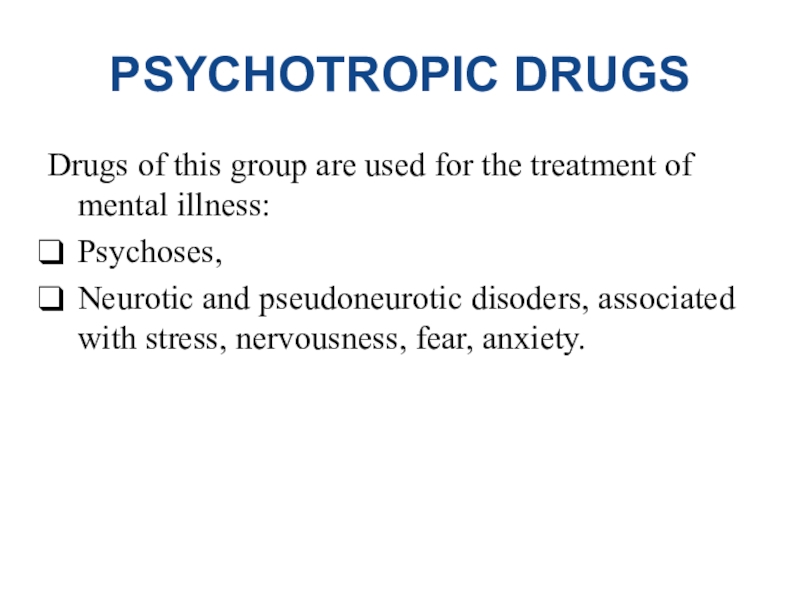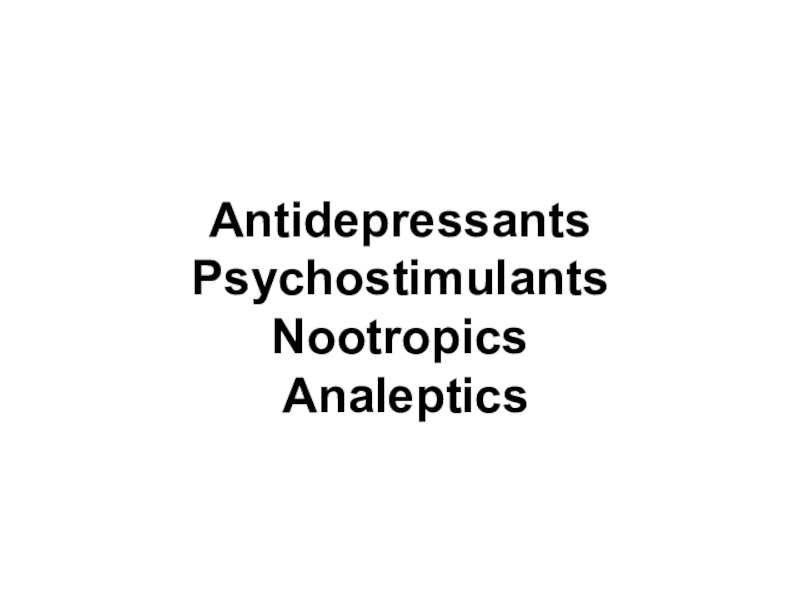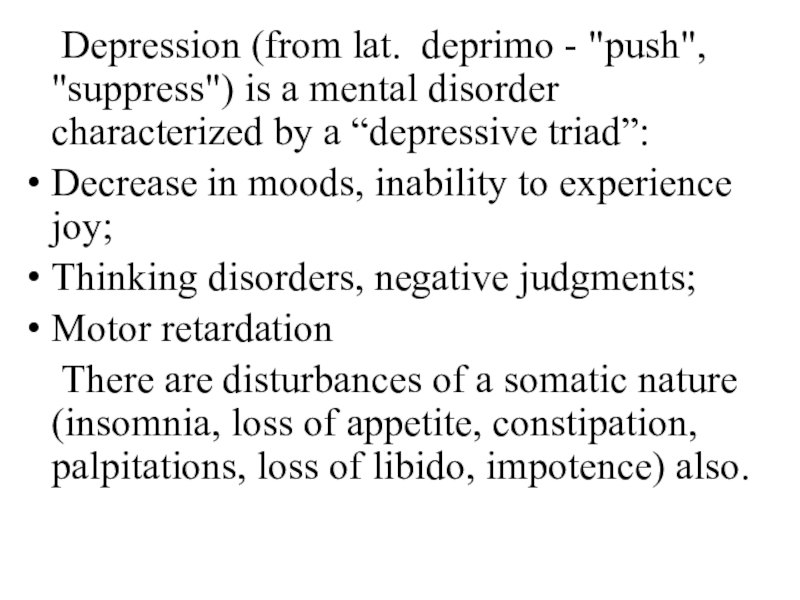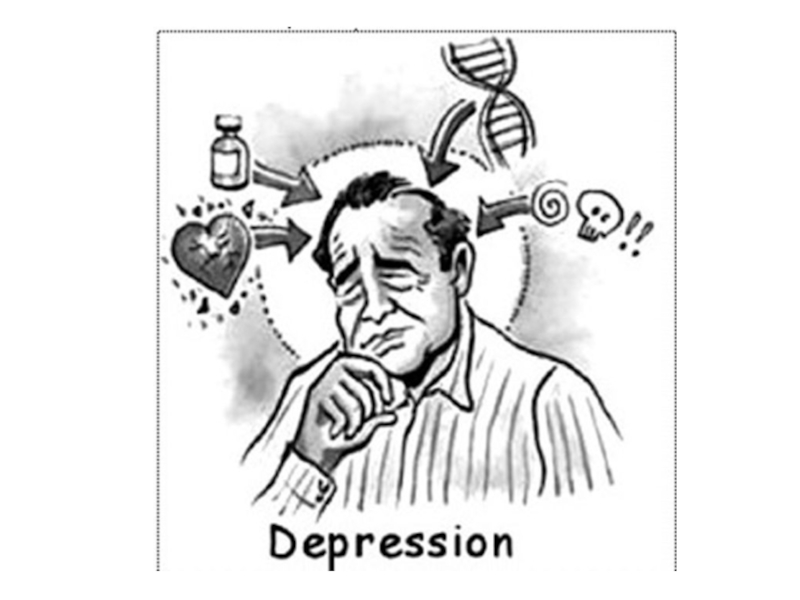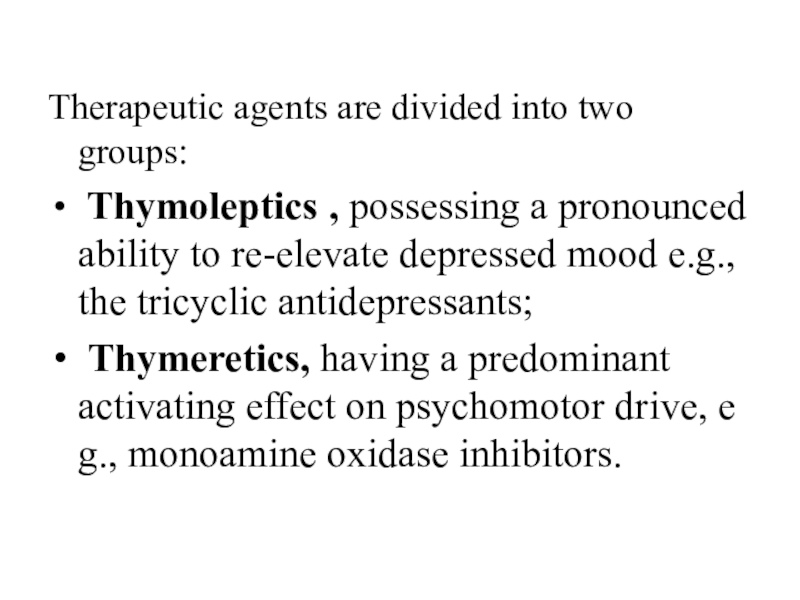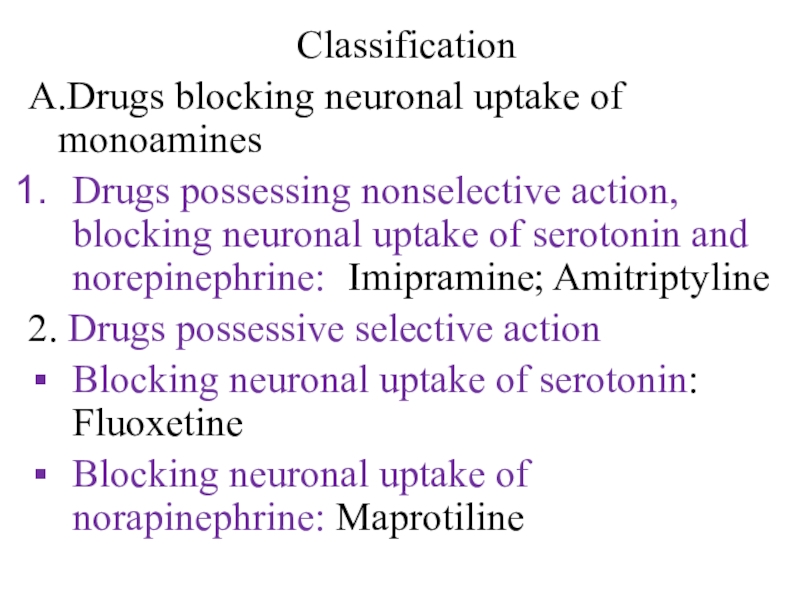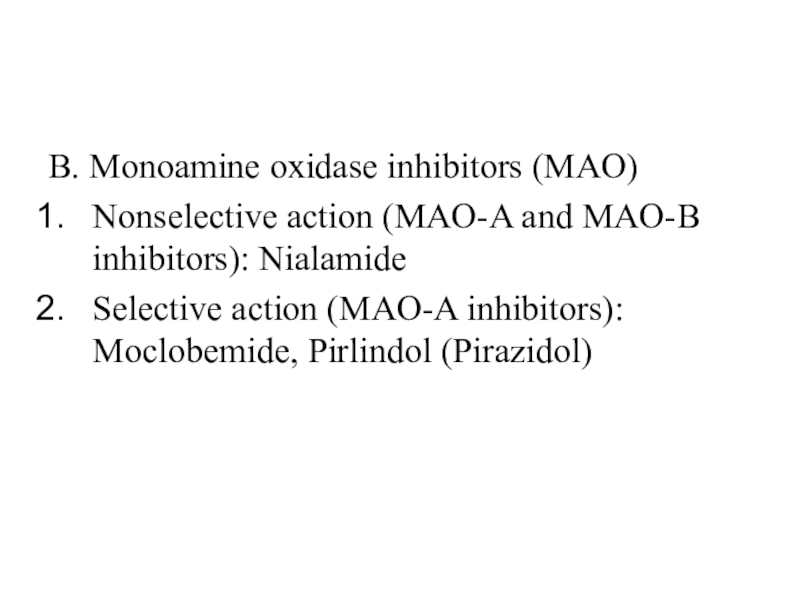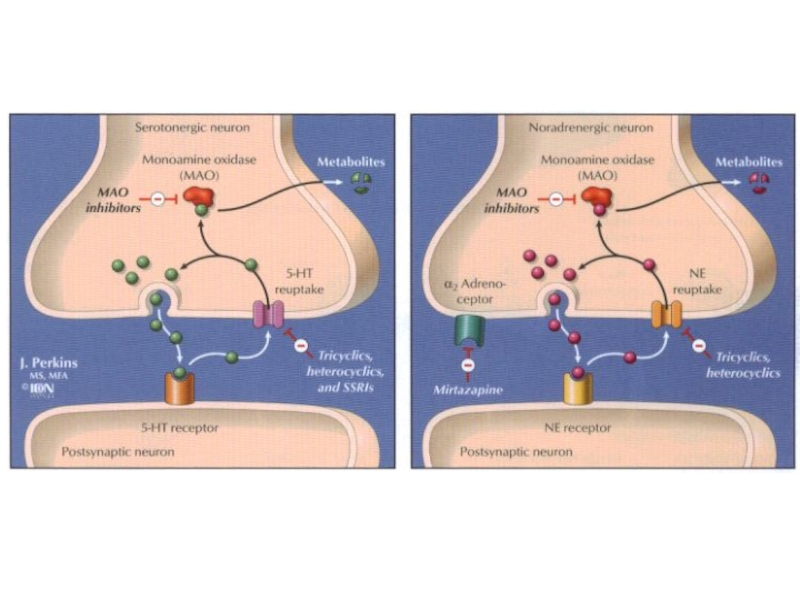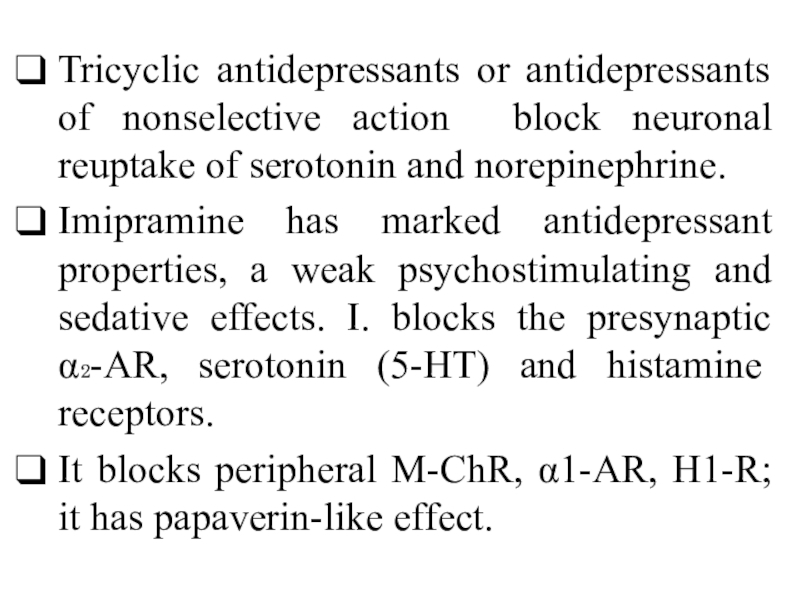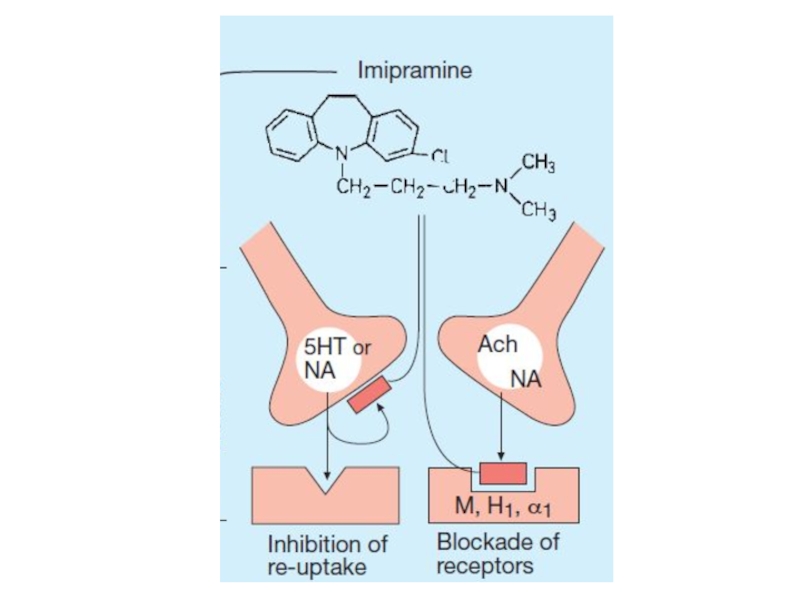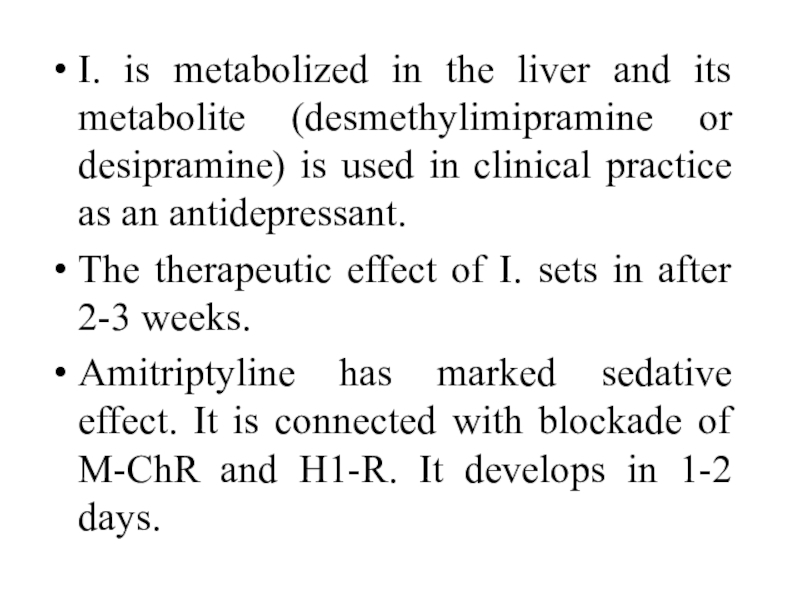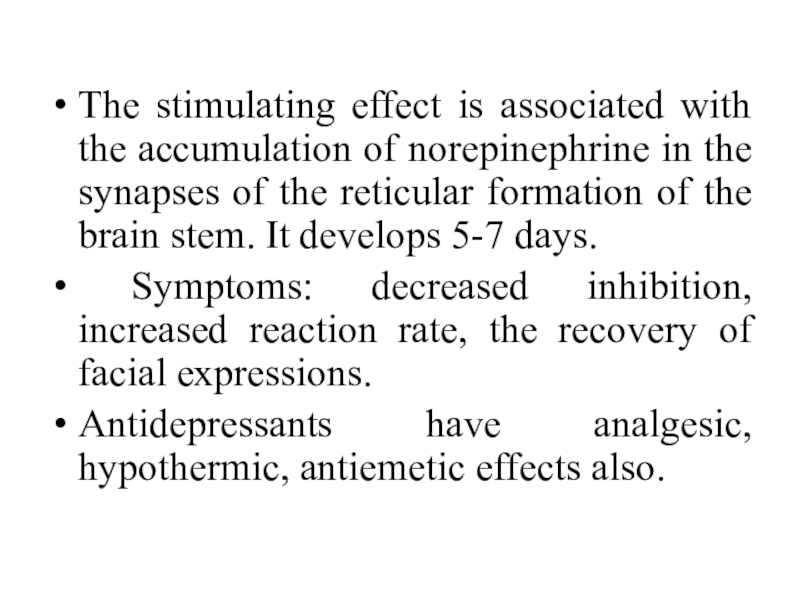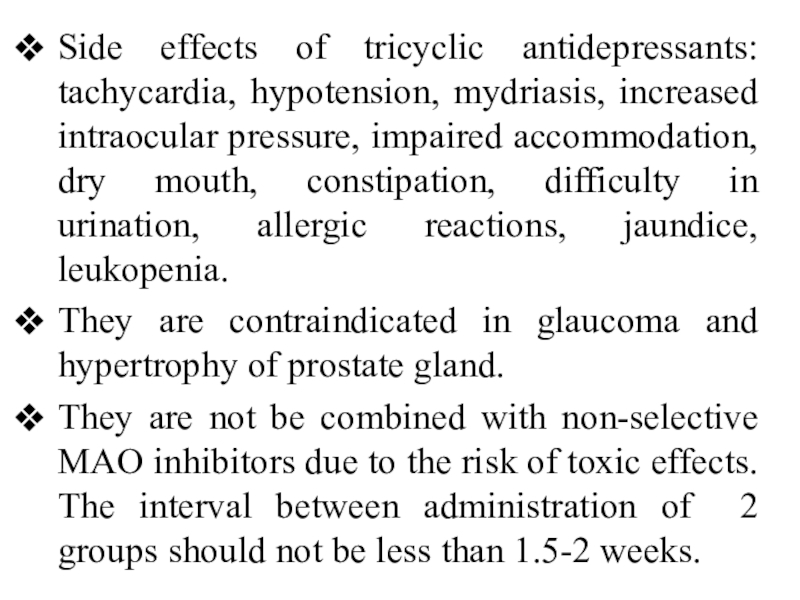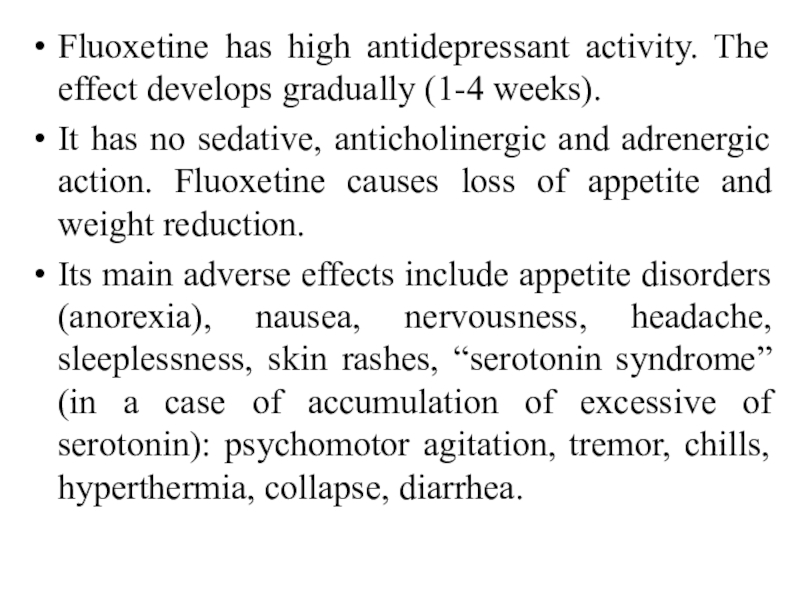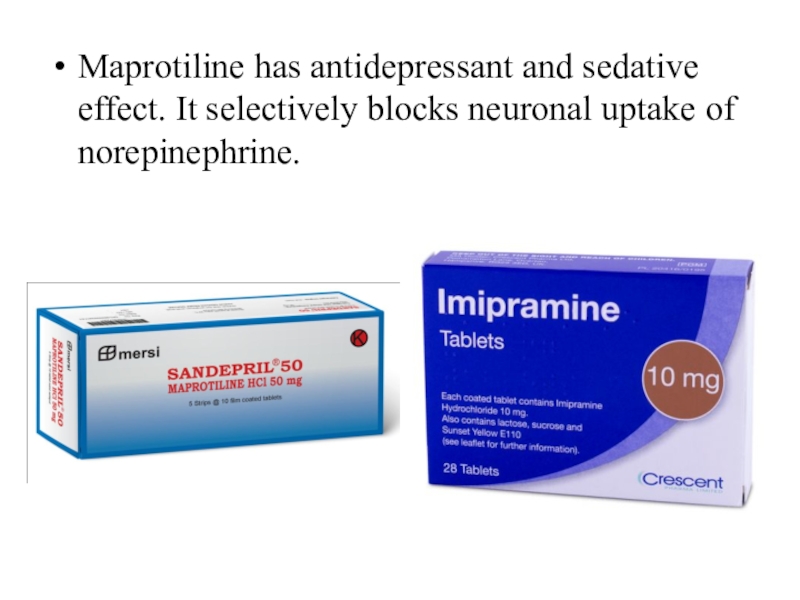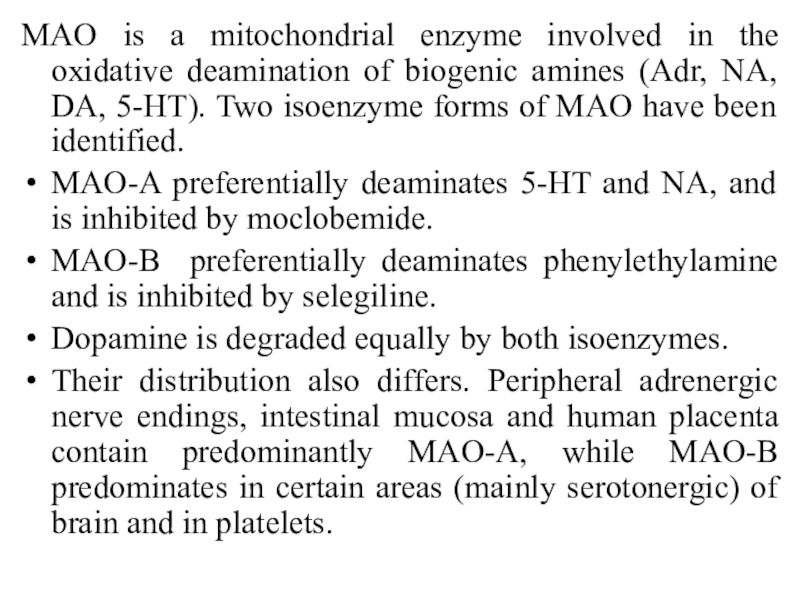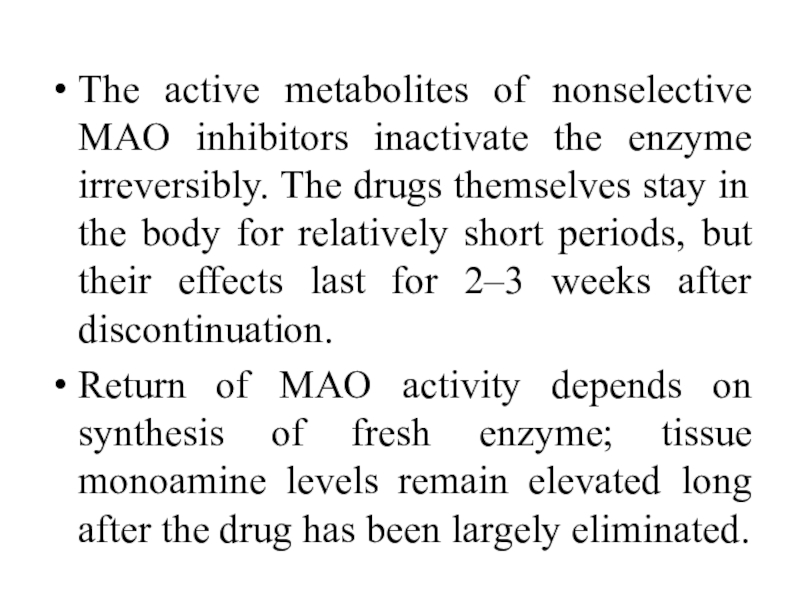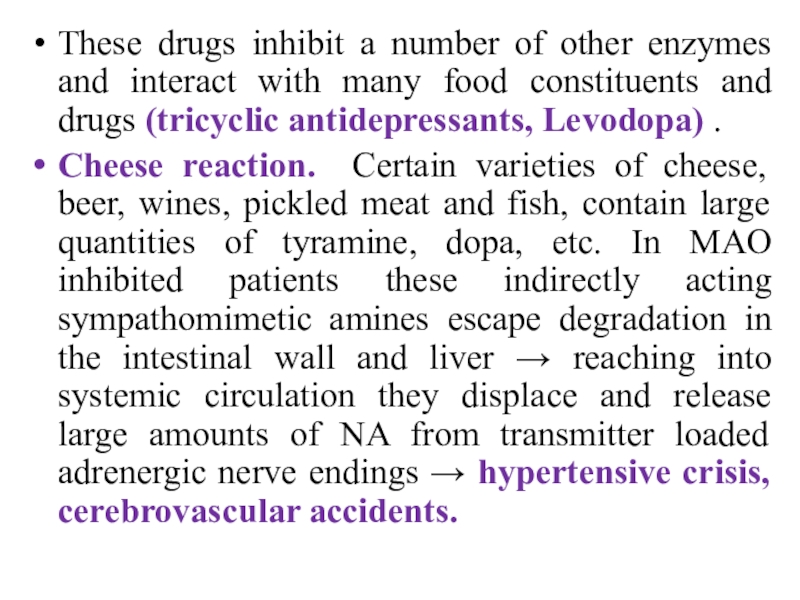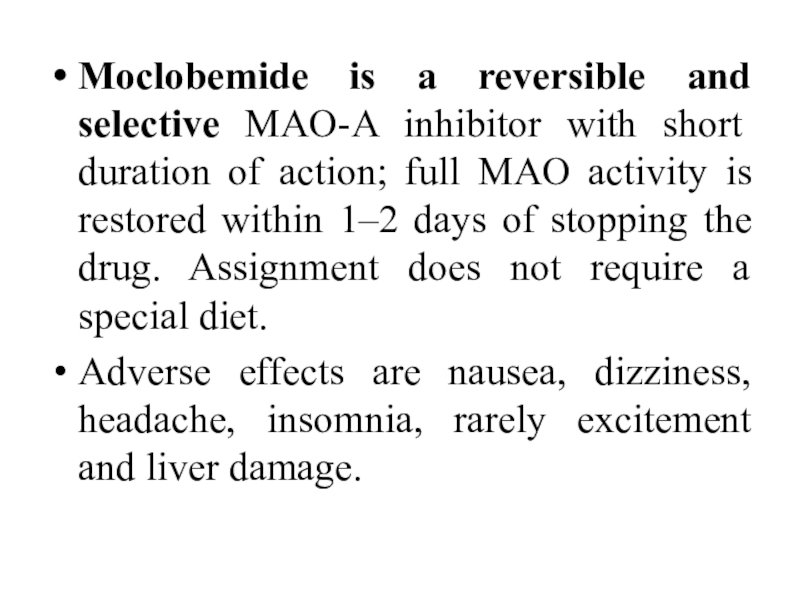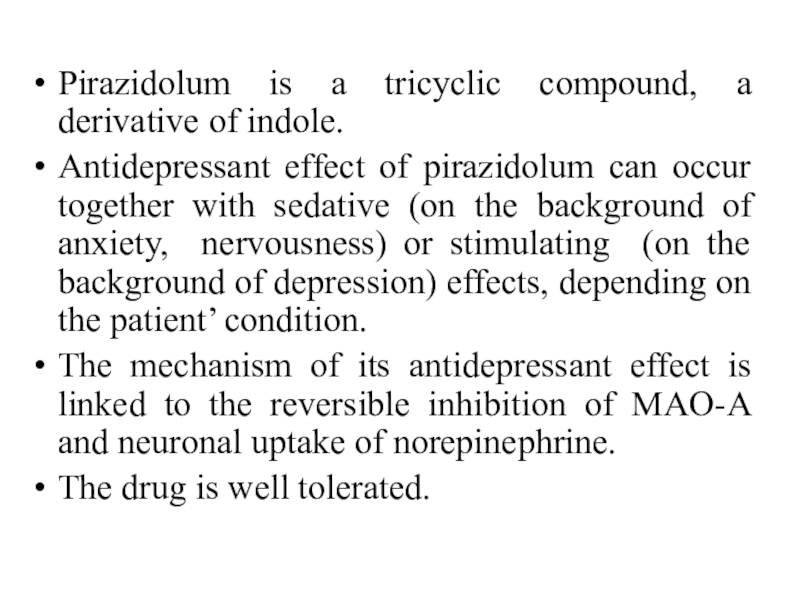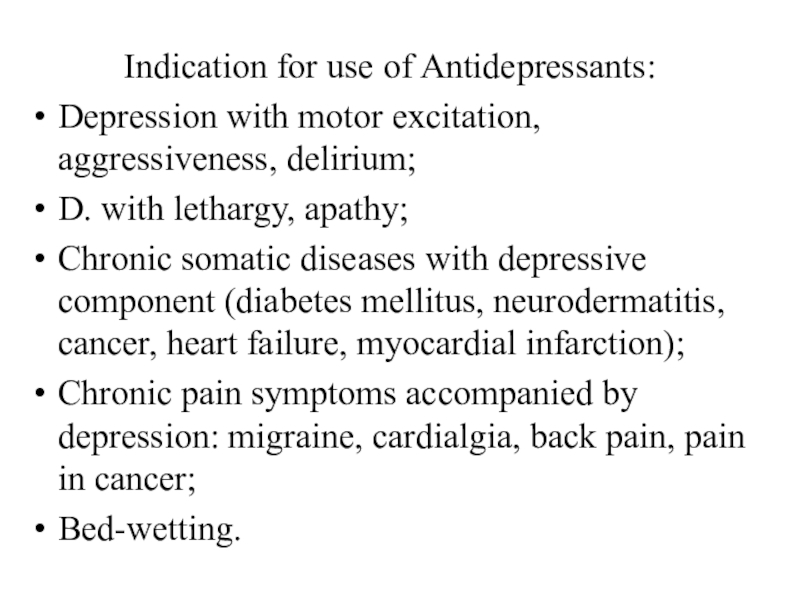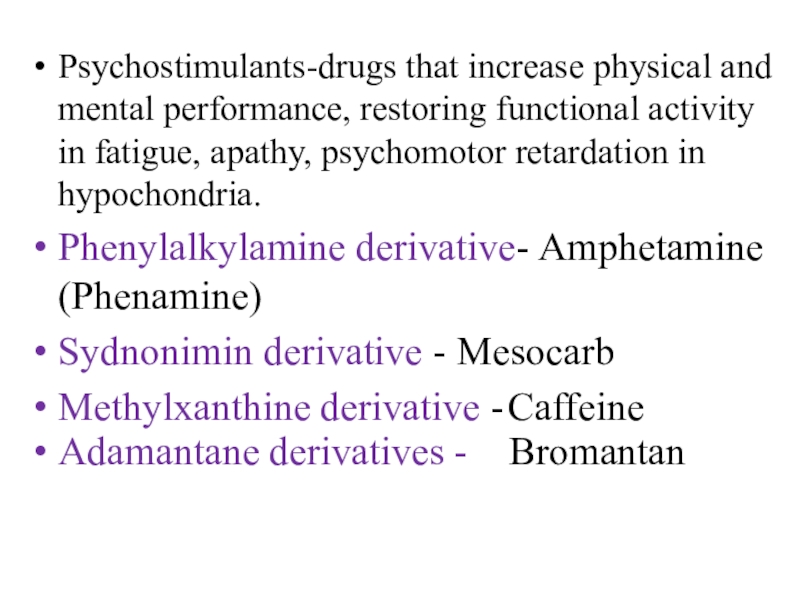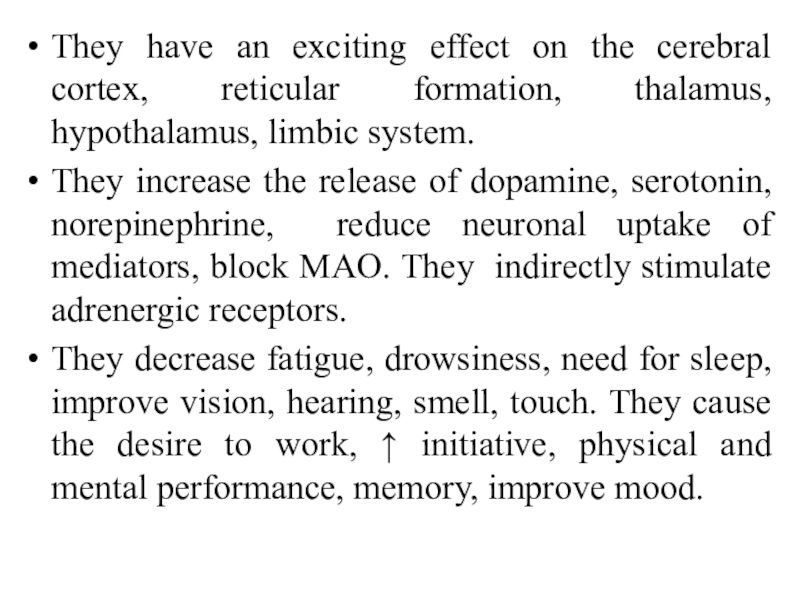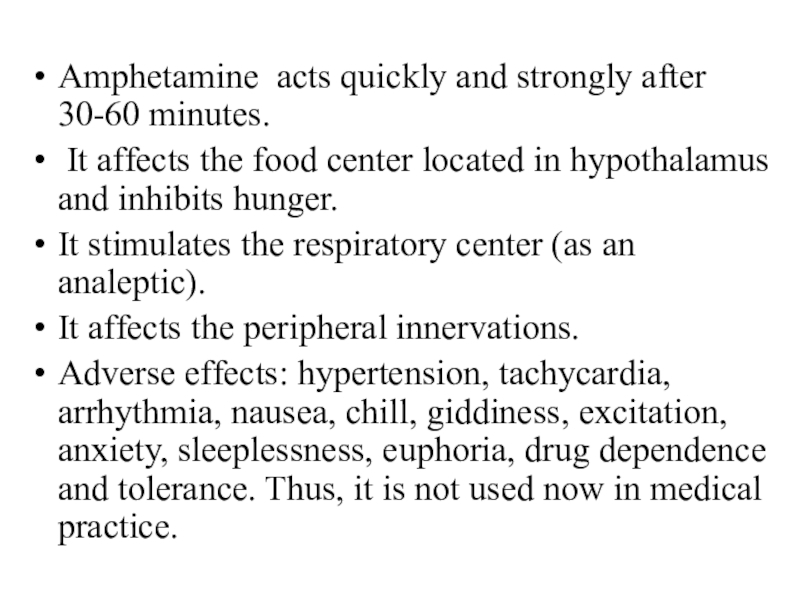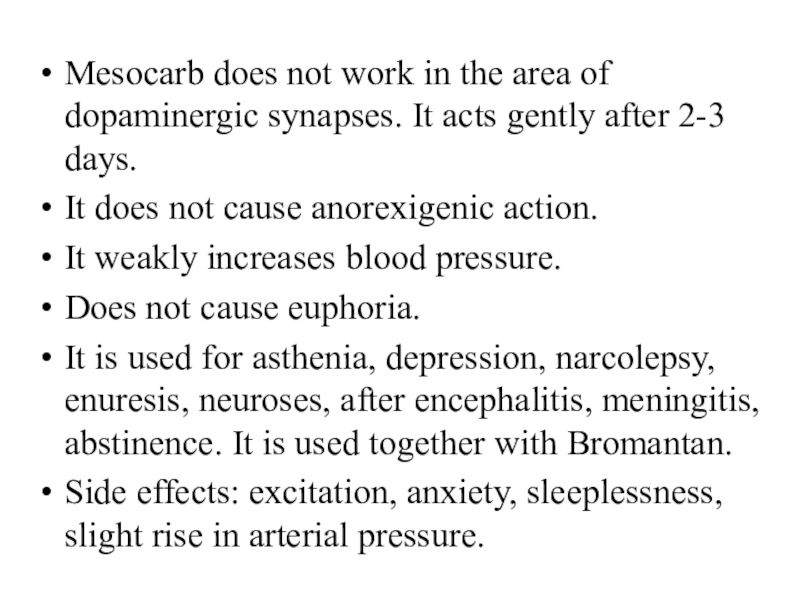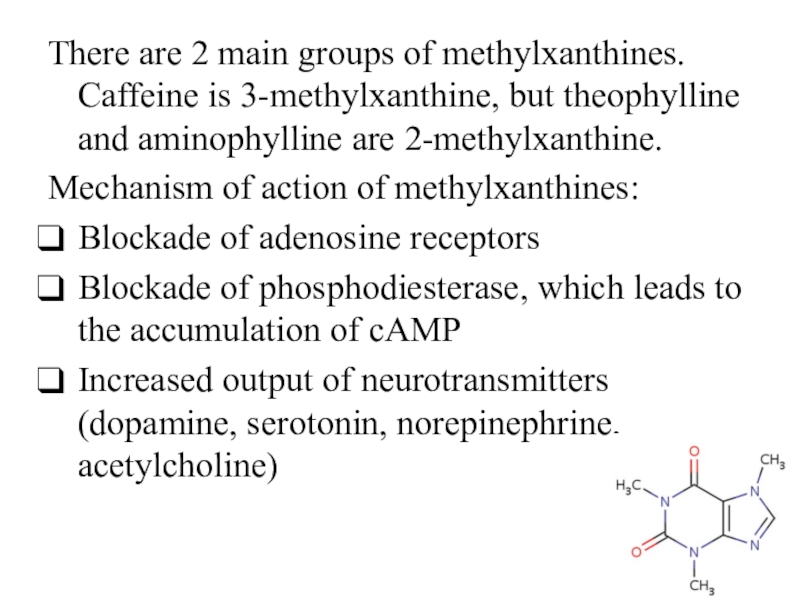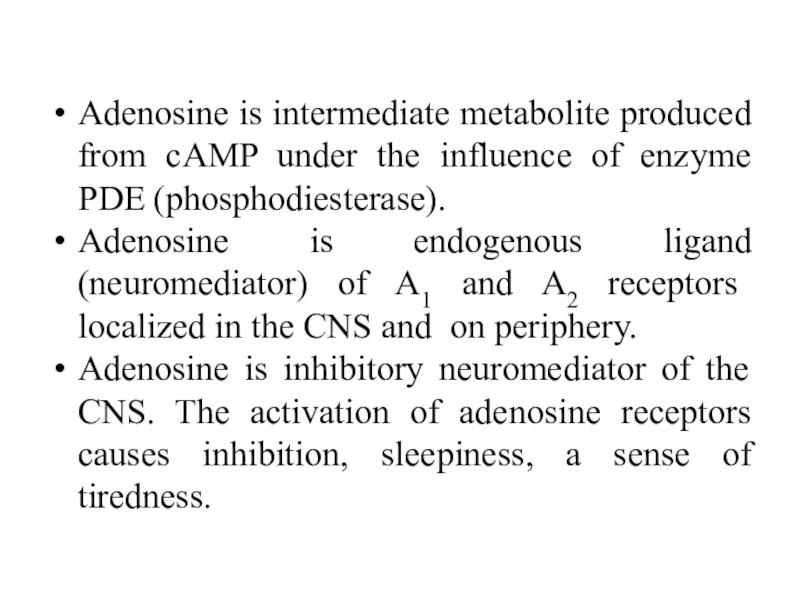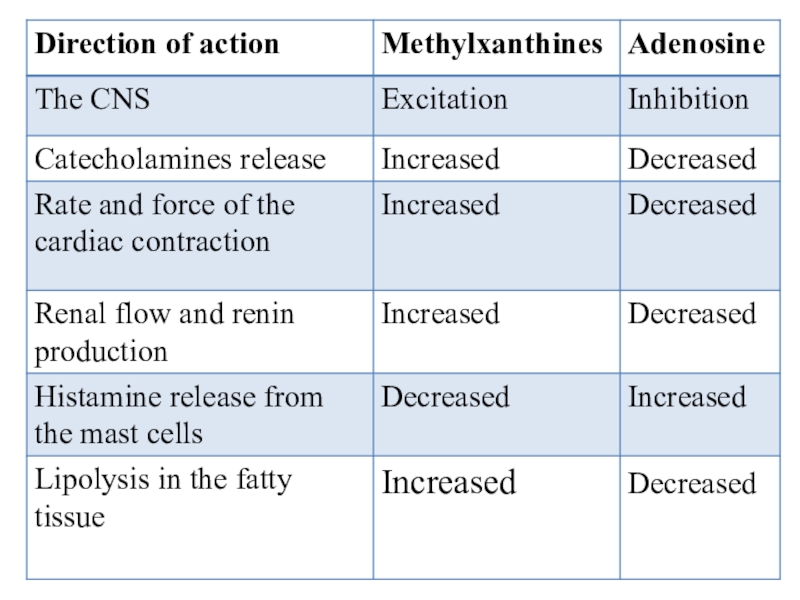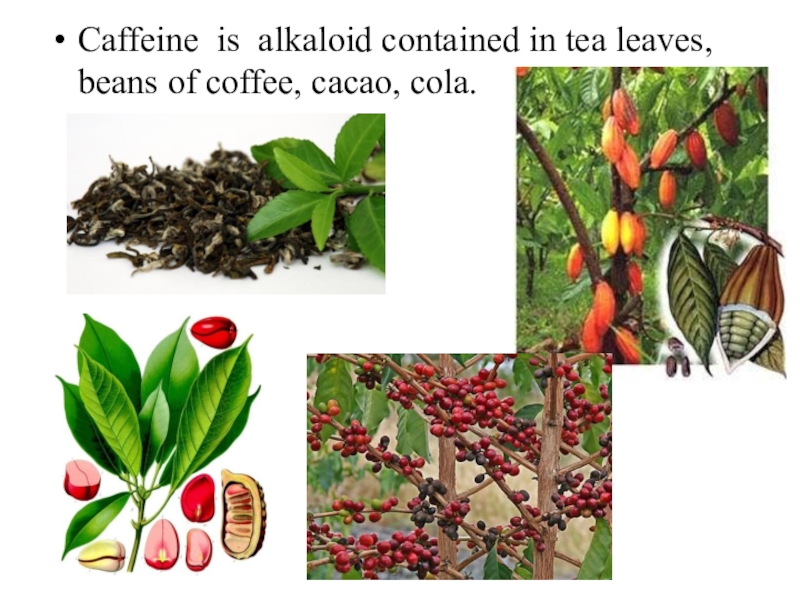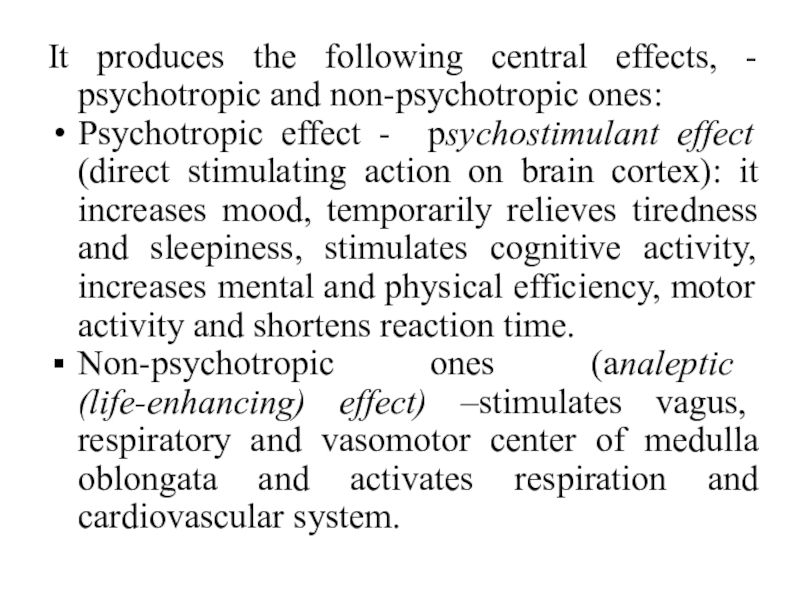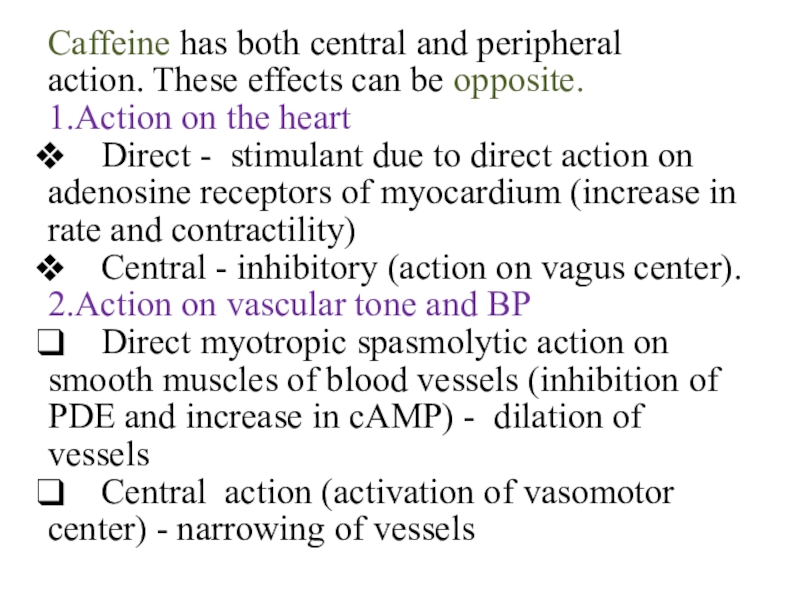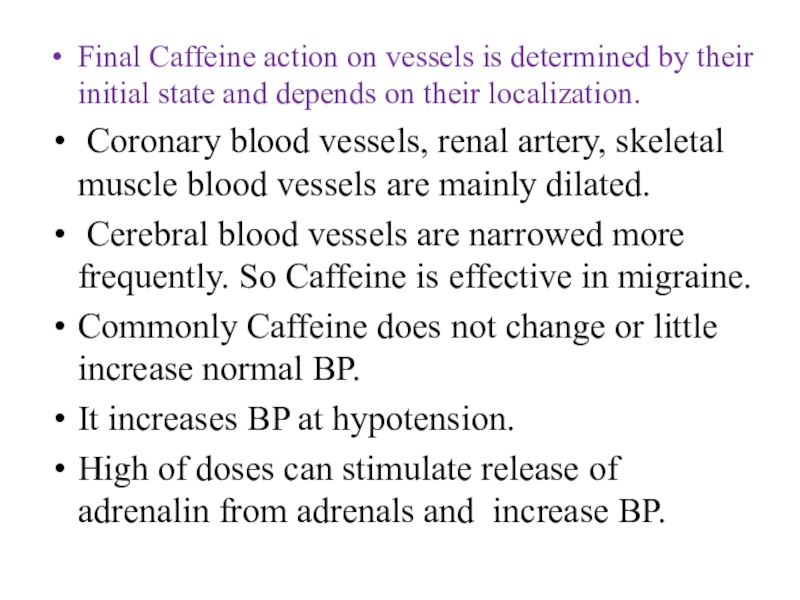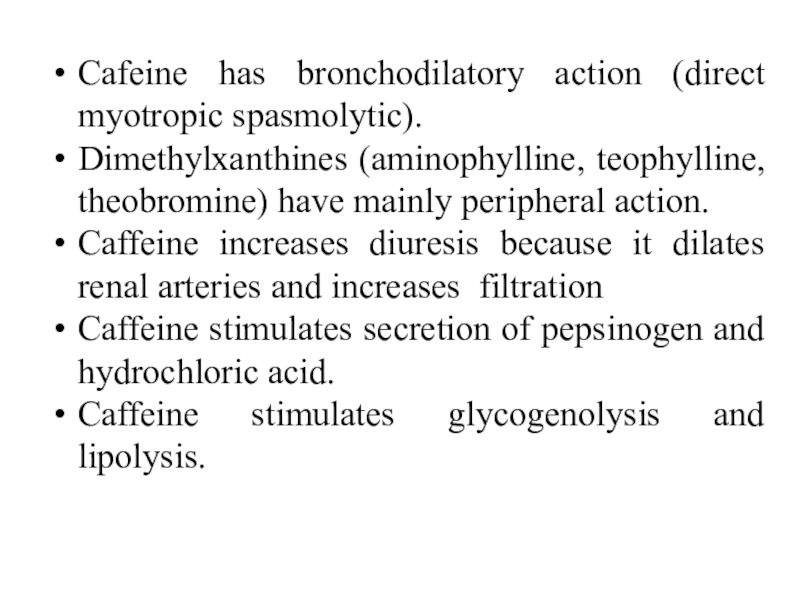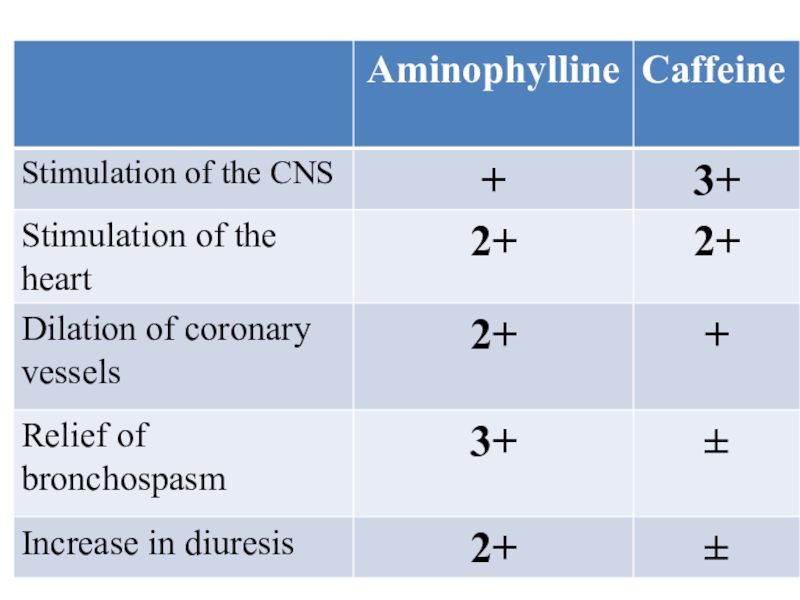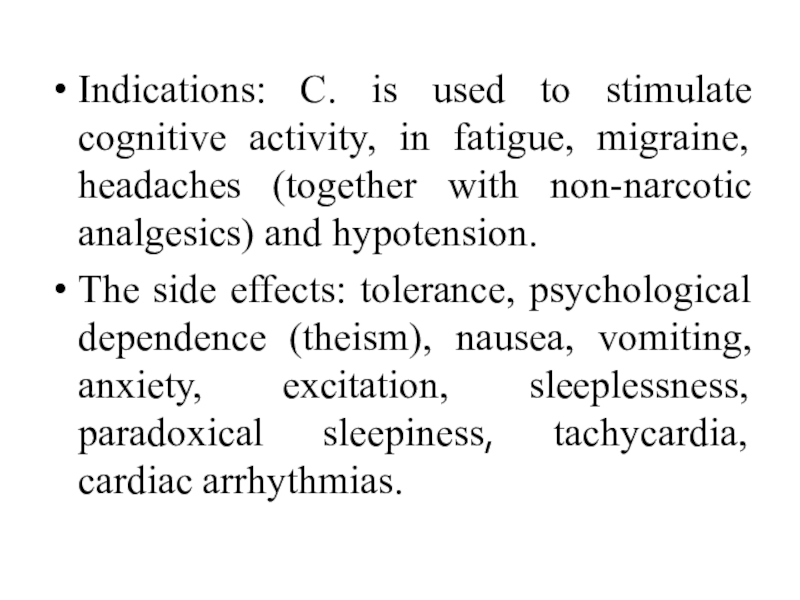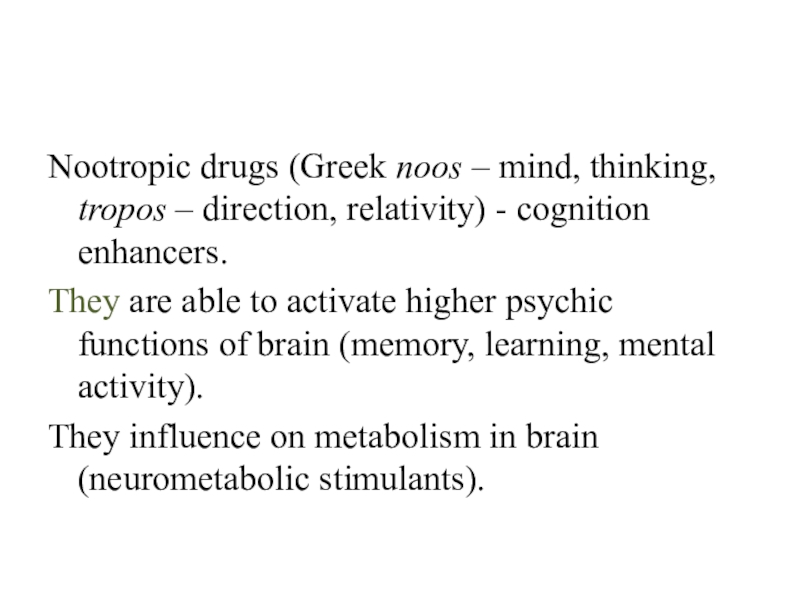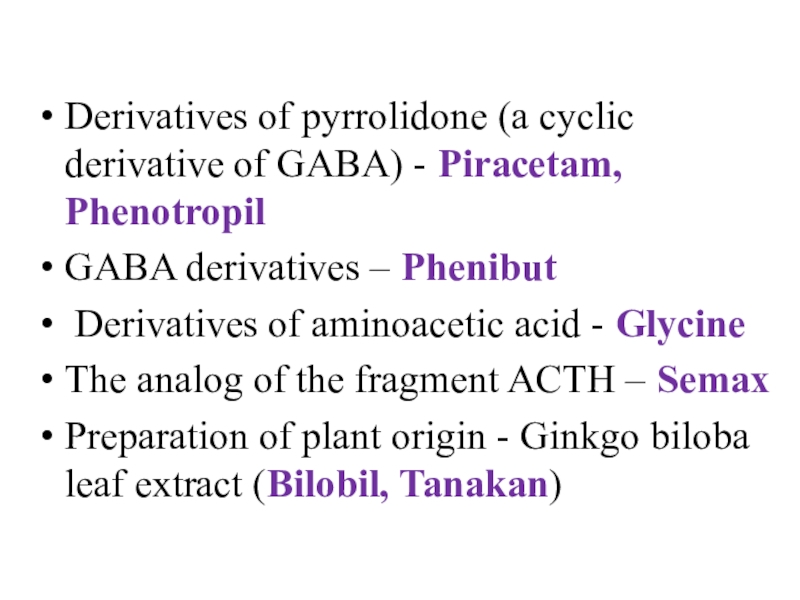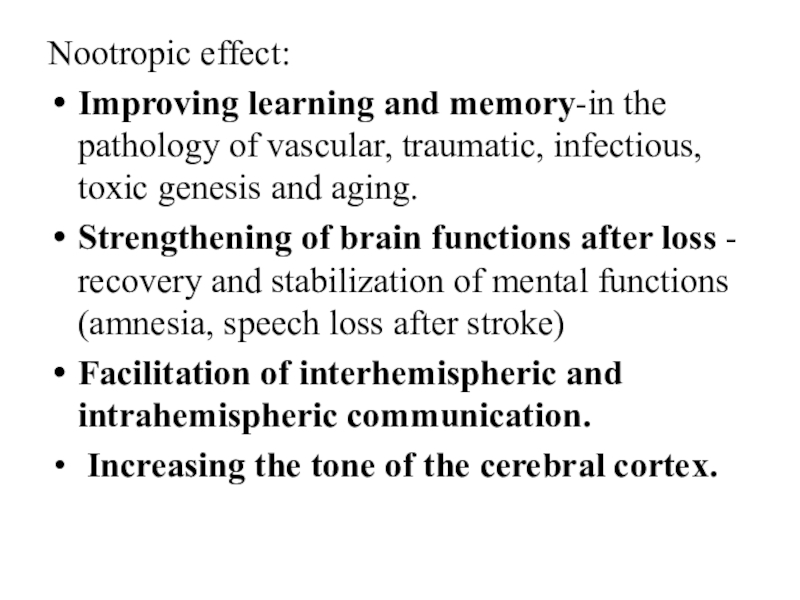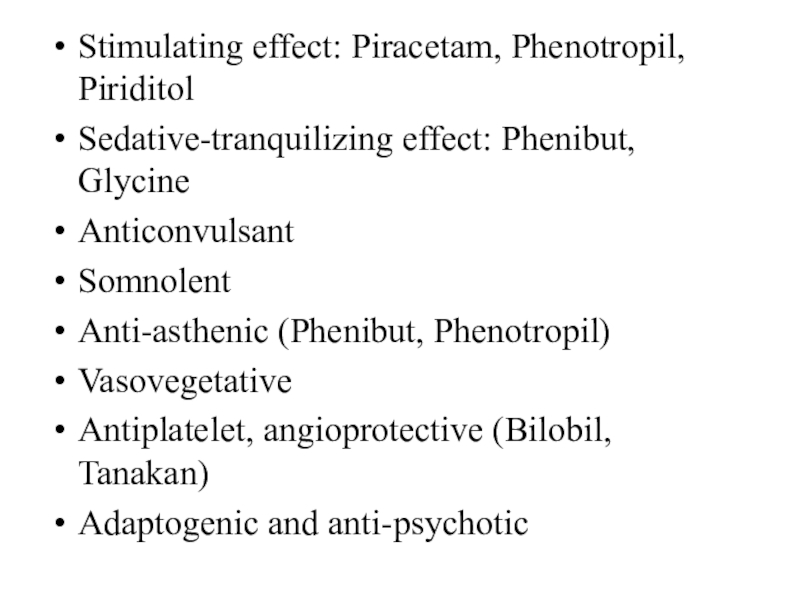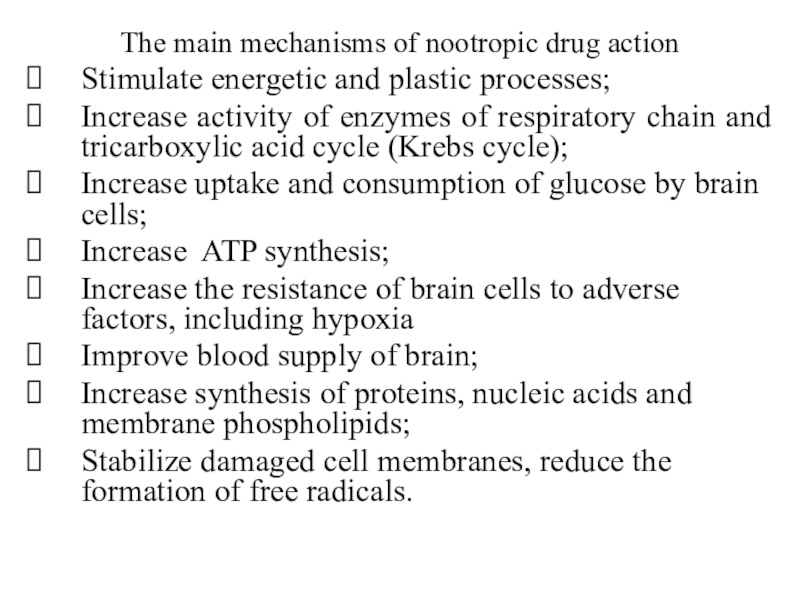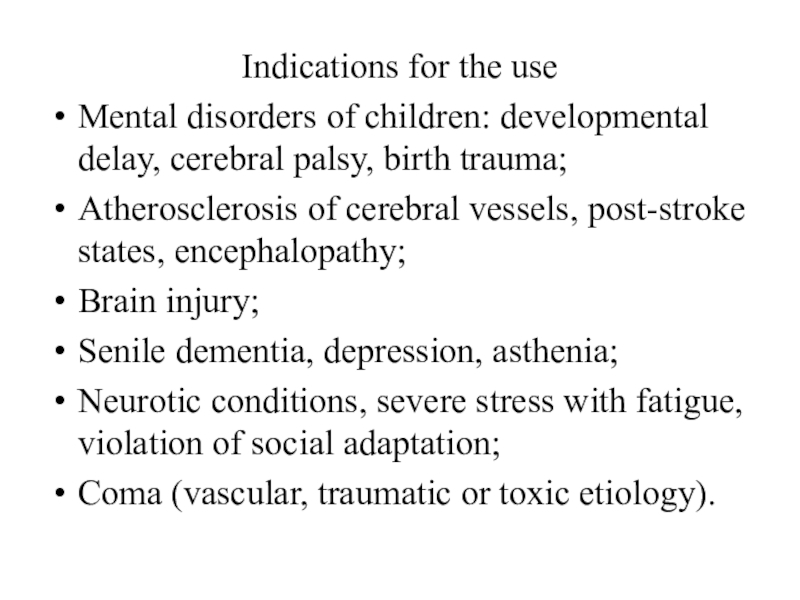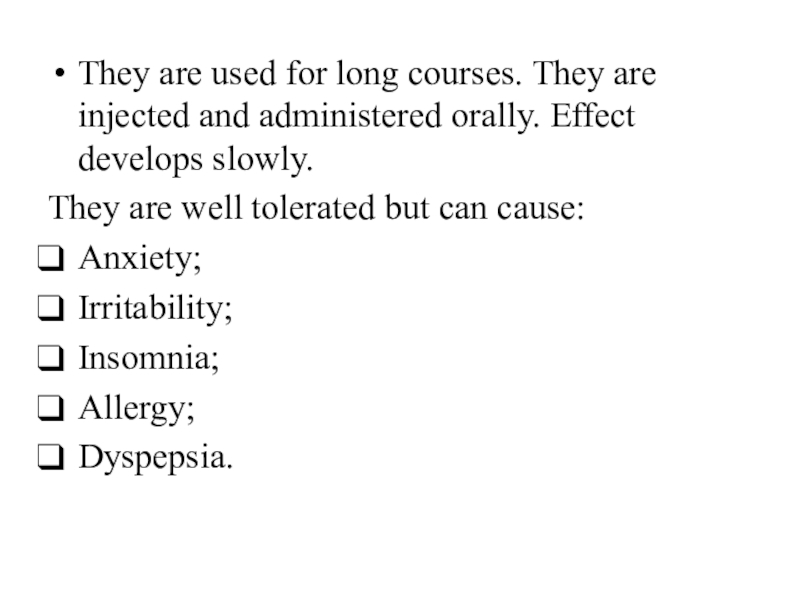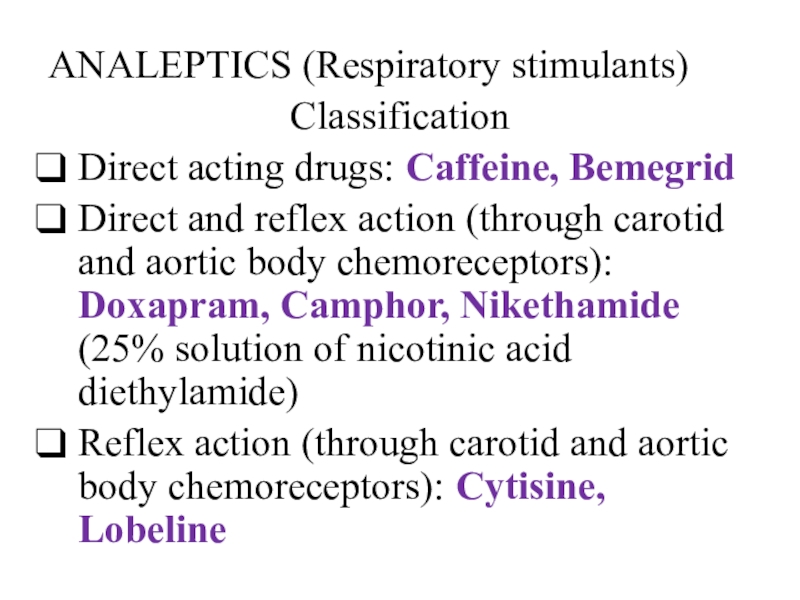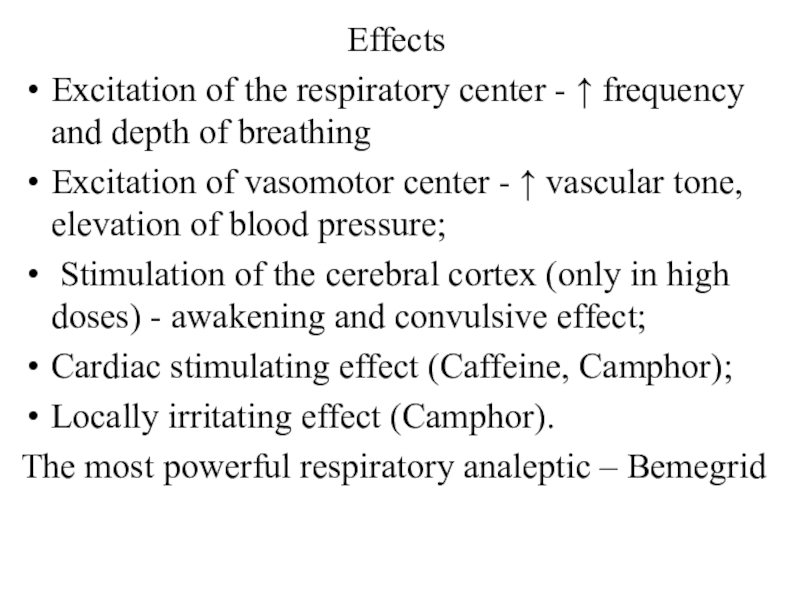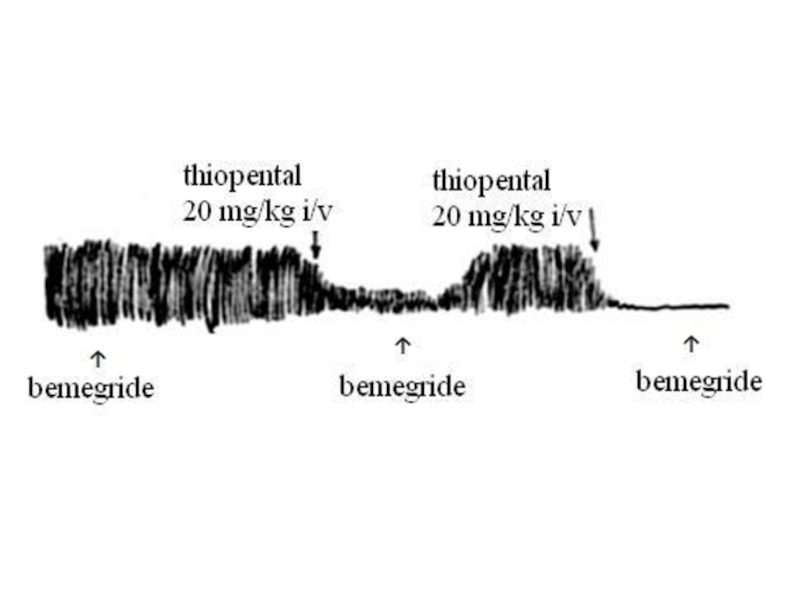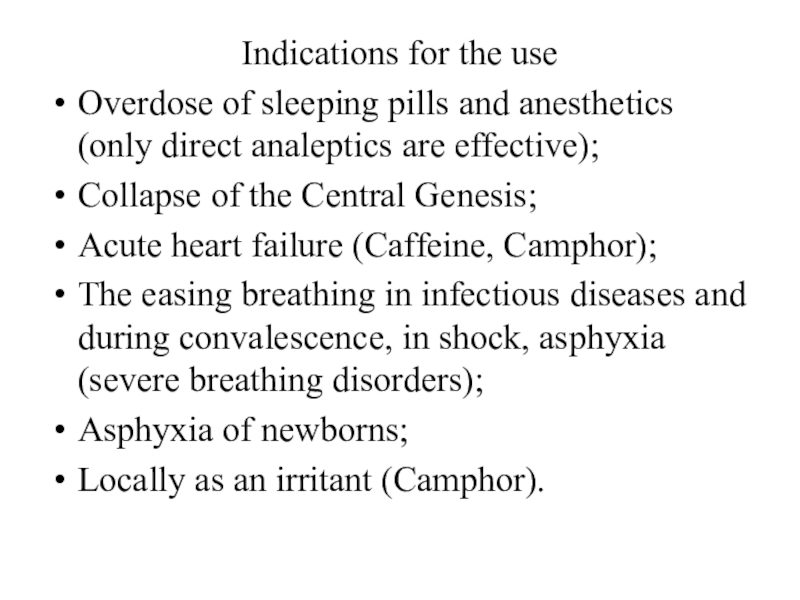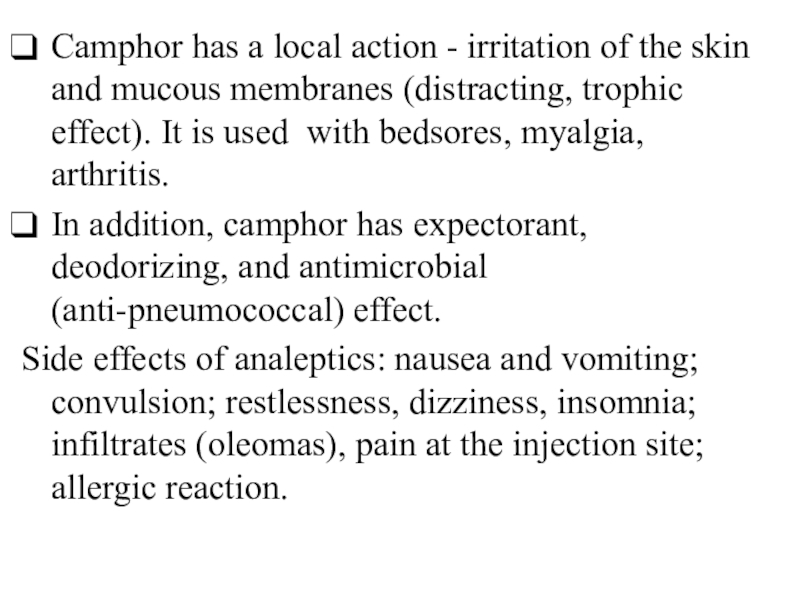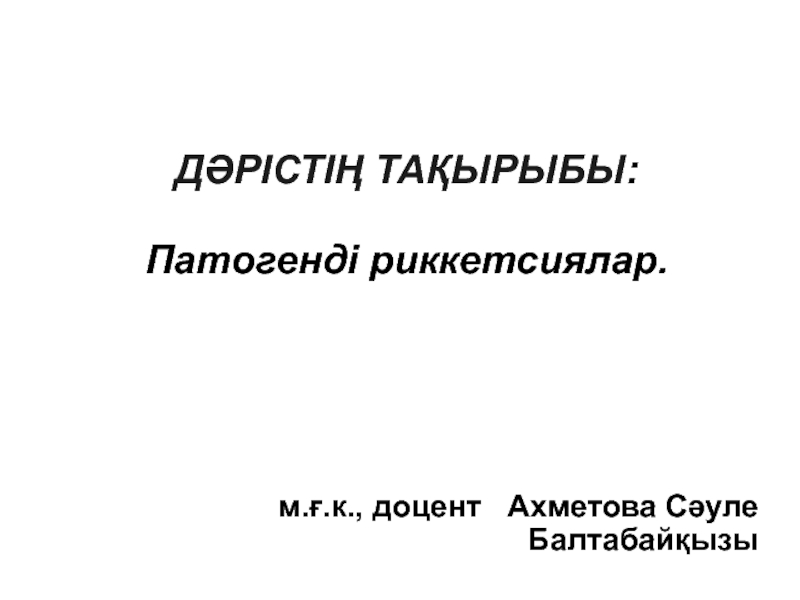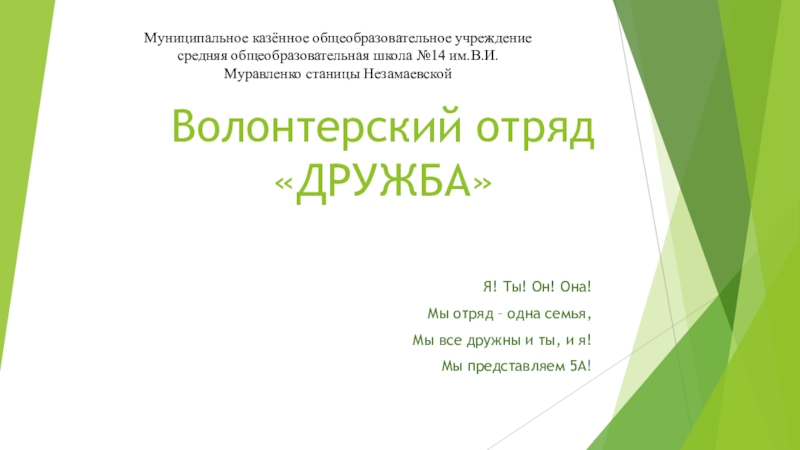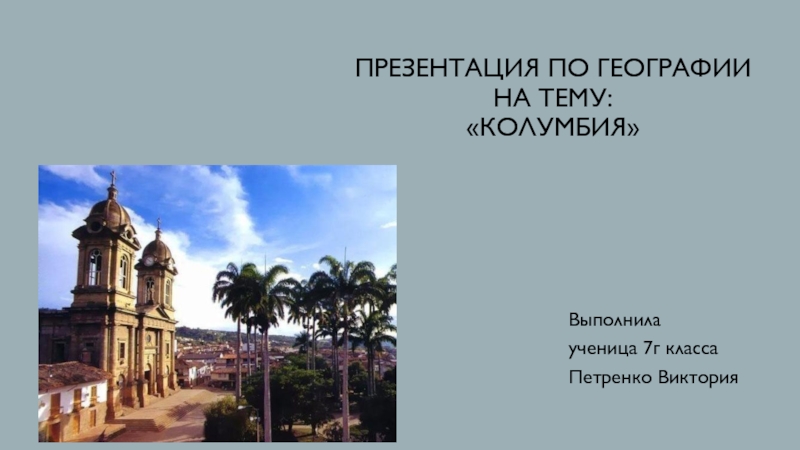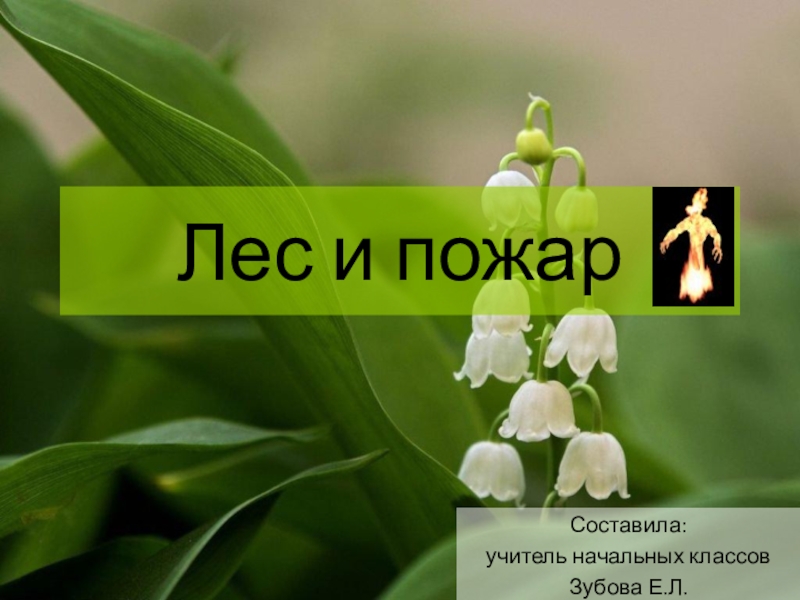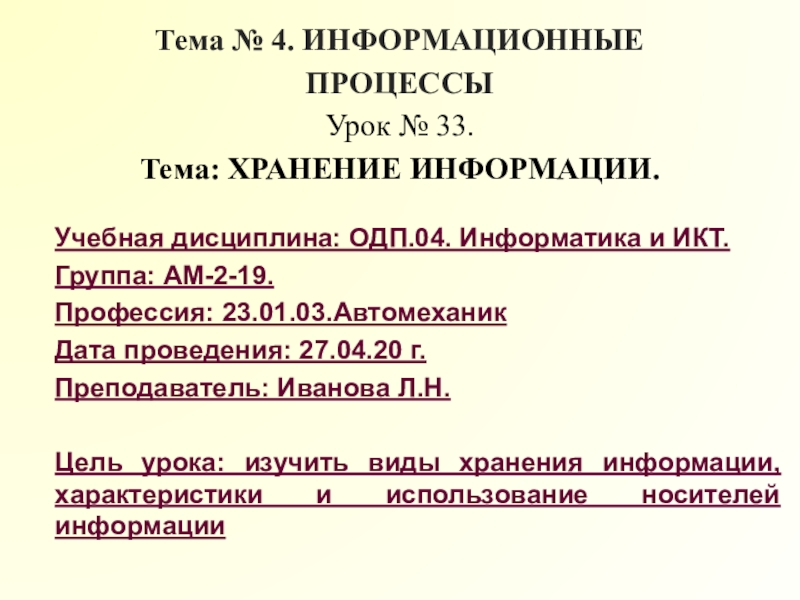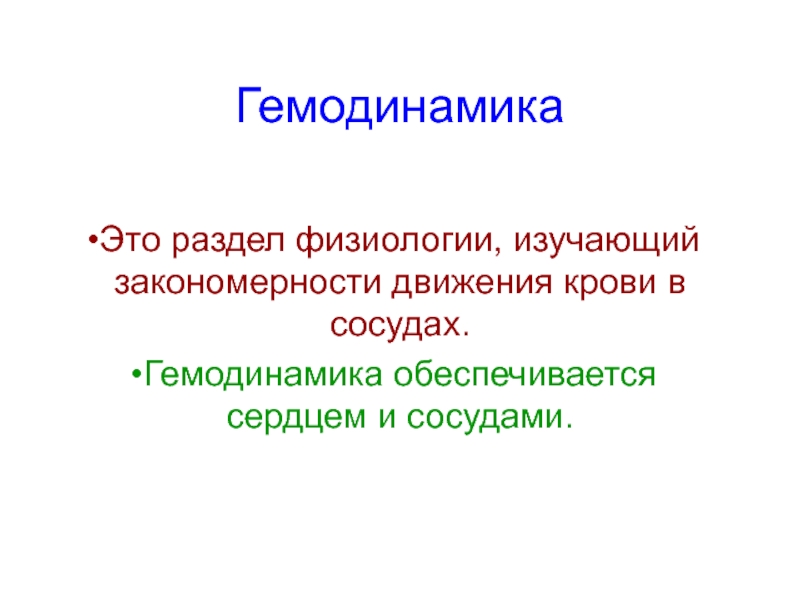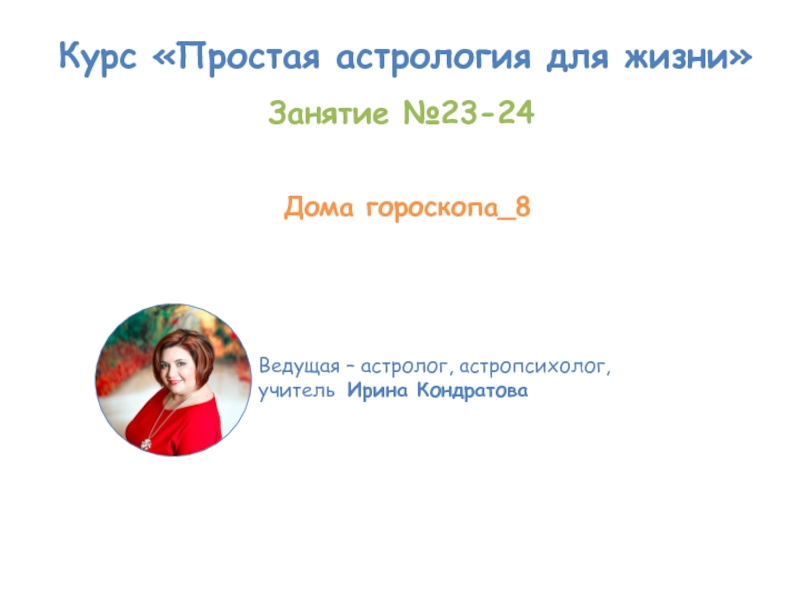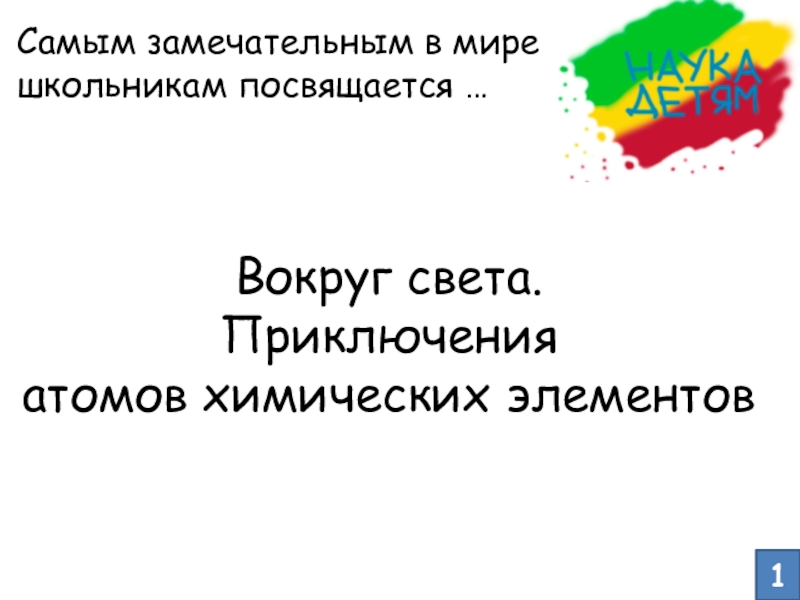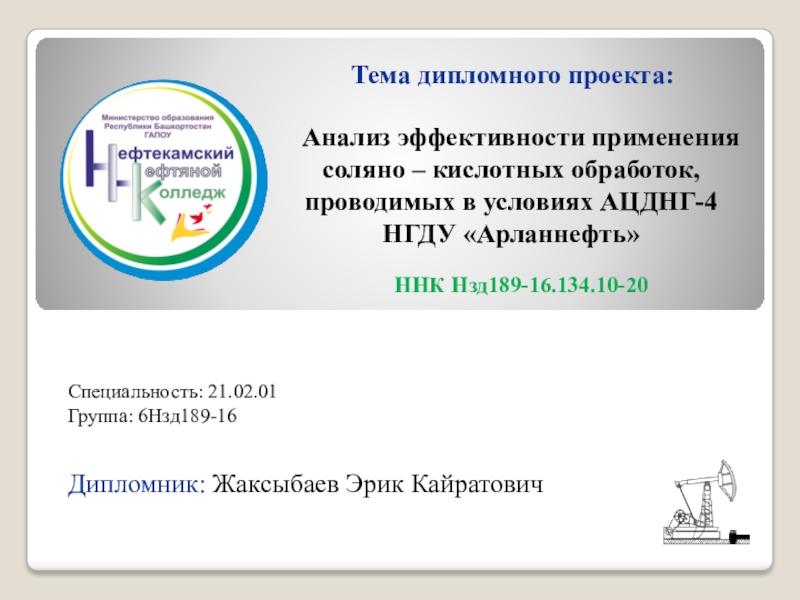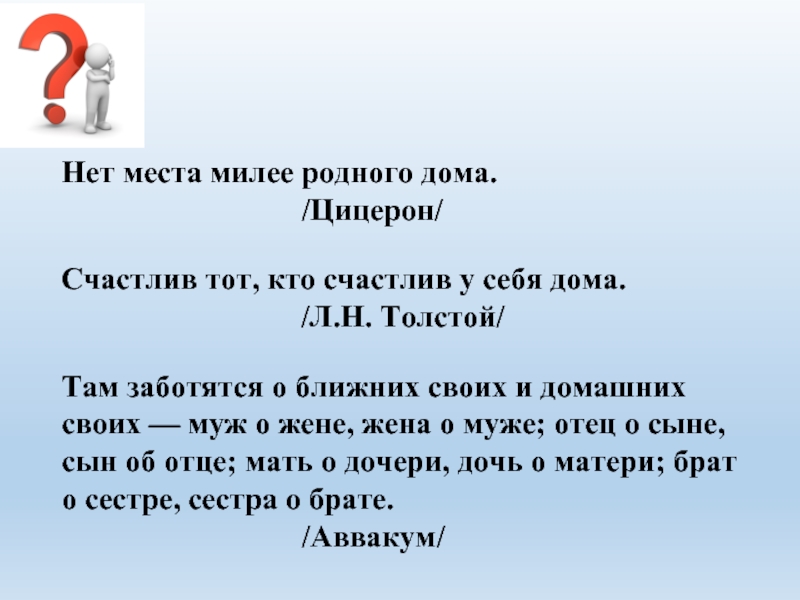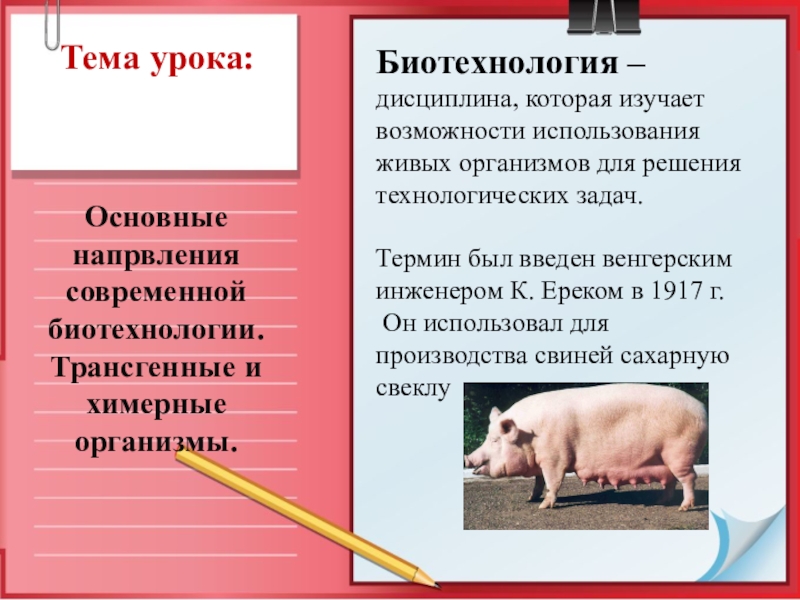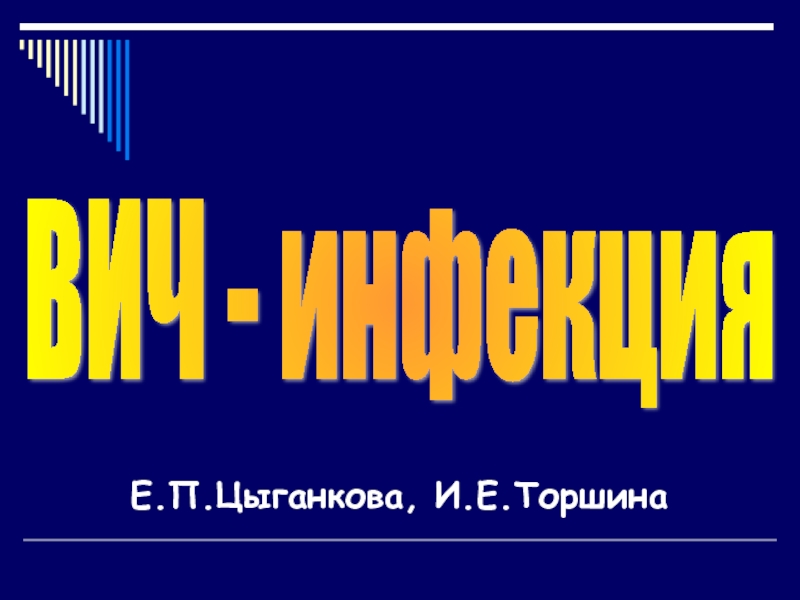Разделы презентаций
- Разное
- Английский язык
- Астрономия
- Алгебра
- Биология
- География
- Геометрия
- Детские презентации
- Информатика
- История
- Литература
- Математика
- Медицина
- Менеджмент
- Музыка
- МХК
- Немецкий язык
- ОБЖ
- Обществознание
- Окружающий мир
- Педагогика
- Русский язык
- Технология
- Физика
- Философия
- Химия
- Шаблоны, картинки для презентаций
- Экология
- Экономика
- Юриспруденция
PSYCHOTROPIC DRUGS
Содержание
- 1. PSYCHOTROPIC DRUGS
- 2. Antidepressants Psychostimulants Nootropics Analeptics
- 3. Depression (from lat. deprimo - "push", "suppress")
- 4. Слайд 4
- 5. Therapeutic agents are divided into two groups:
- 6. ClassificationA.Drugs blocking neuronal uptake of monoaminesDrugs possessing
- 7. B. Monoamine oxidase inhibitors (MAO)Nonselective action (MAO-A
- 8. Слайд 8
- 9. Tricyclic antidepressants or antidepressants of nonselective action
- 10. Слайд 10
- 11. I. is metabolized in the liver and
- 12. The stimulating effect is associated with the
- 13. Side effects of tricyclic antidepressants: tachycardia, hypotension,
- 14. Fluoxetine has high antidepressant activity. The effect
- 15. Maprotiline has antidepressant and sedative effect. It selectively blocks neuronal uptake of norepinephrine.
- 16. MAO is a mitochondrial enzyme involved in
- 17. The active metabolites of nonselective MAO inhibitors
- 18. These drugs inhibit a number of other
- 19. Moclobemide is a reversible and selective MAO-A
- 20. Pirazidolum is a tricyclic compound, a derivative
- 21. Indication for use of Antidepressants:Depression with motor
- 22. Psychostimulants-drugs that increase physical and mental performance,
- 23. They have an exciting effect on the
- 24. Amphetamine acts quickly and strongly after 30-60
- 25. Mesocarb does not work in the area
- 26. There are 2 main groups of methylxanthines.
- 27. Adenosine is intermediate metabolite produced from cAMP
- 28. Слайд 28
- 29. Caffeine is alkaloid contained in tea leaves, beans of coffee, cacao, cola.
- 30. It produces the following central effects, -
- 31. Caffeine has both central and peripheralaction. These
- 32. Final Caffeine action on vessels is determined
- 33. Cafeine has bronchodilatory action (direct myotropic spasmolytic).Dimethylxanthines
- 34. Слайд 34
- 35. Indications: C. is used to stimulate cognitive
- 36. Nootropic drugs (Greek noos – mind, thinking,
- 37. Derivatives of pyrrolidone (a cyclic derivative of
- 38. Nootropic effect:Improving learning and memory-in the pathology
- 39. Stimulating effect: Piracetam, Phenotropil, PiriditolSedative-tranquilizing effect: Phenibut, GlycineAnticonvulsantSomnolentAnti-asthenic (Phenibut, Phenotropil)VasovegetativeAntiplatelet, angioprotective (Bilobil, Tanakan)Adaptogenic and anti-psychotic
- 40. The main mechanisms of nootropic drug action
- 41. Indications for the useMental disorders of children:
- 42. They are used for long courses. They
- 43. ANALEPTICS (Respiratory stimulants)ClassificationDirect acting drugs: Caffeine, BemegridDirect
- 44. EffectsExcitation of the respiratory center - ↑
- 45. Слайд 45
- 46. Indications for the useOverdose of sleeping pills
- 47. Camphor has a local action - irritation
- 48. Скачать презентанцию
Antidepressants Psychostimulants Nootropics Analeptics
Слайды и текст этой презентации
Слайд 1PSYCHOTROPIC DRUGS
Drugs of this group are used for the treatment
of mental illness:
fear, anxiety.Слайд 3 Depression (from lat. deprimo - "push", "suppress") is a mental
disorder characterized by a “depressive triad”:
Decrease in moods, inability to
experience joy;Thinking disorders, negative judgments;
Motor retardation
There are disturbances of a somatic nature (insomnia, loss of appetite, constipation, palpitations, loss of libido, impotence) also.
Слайд 5Therapeutic agents are divided into two groups:
Thymoleptics , possessing
a pronounced ability to re-elevate depressed mood e.g., the tricyclic
antidepressants;Thymeretics, having a predominant activating effect on psychomotor drive, e g., monoamine oxidase inhibitors.
Слайд 6Classification
A.Drugs blocking neuronal uptake of monoamines
Drugs possessing nonselective action, blocking
neuronal uptake of serotonin and norepinephrine: Imipramine; Amitriptyline
2. Drugs possessive
selective actionBlocking neuronal uptake of serotonin: Fluoxetine
Blocking neuronal uptake of norapinephrine: Maprotiline
Слайд 7B. Monoamine oxidase inhibitors (MAO)
Nonselective action (MAO-A and MAO-B inhibitors):
Nialamide
Selective action (MAO-A inhibitors): Moclobemide, Pirlindol (Pirazidol)
Слайд 9Tricyclic antidepressants or antidepressants of nonselective action block neuronal reuptake
of serotonin and norepinephrine.
Imipramine has marked antidepressant properties, a
weak psychostimulating and sedative effects. I. blocks the presynaptic α₂-AR, serotonin (5-HT) and histamine receptors. It blocks peripheral M-ChR, α1-AR, H1-R; it has papaverin-like effect.
Слайд 11I. is metabolized in the liver and its metabolite (desmethylimipramine
or desipramine) is used in clinical practice as an antidepressant.
The therapeutic effect of I. sets in after 2-3 weeks.
Amitriptyline has marked sedative effect. It is connected with blockade of M-ChR and H1-R. It develops in 1-2 days.
Слайд 12The stimulating effect is associated with the accumulation of norepinephrine
in the synapses of the reticular formation of the brain
stem. It develops 5-7 days.Symptoms: decreased inhibition, increased reaction rate, the recovery of facial expressions.
Antidepressants have analgesic, hypothermic, antiemetic effects also.
Слайд 13Side effects of tricyclic antidepressants: tachycardia, hypotension, mydriasis, increased intraocular
pressure, impaired accommodation, dry mouth, constipation, difficulty in urination, allergic
reactions, jaundice, leukopenia.They are contraindicated in glaucoma and hypertrophy of prostate gland.
They are not be combined with non-selective MAO inhibitors due to the risk of toxic effects. The interval between administration of 2 groups should not be less than 1.5-2 weeks.
Слайд 14Fluoxetine has high antidepressant activity. The effect develops gradually (1-4
weeks).
It has no sedative, anticholinergic and adrenergic action. Fluoxetine
causes loss of appetite and weight reduction. Its main adverse effects include appetite disorders (anorexia), nausea, nervousness, headache, sleeplessness, skin rashes, “serotonin syndrome” (in a case of accumulation of excessive of serotonin): psychomotor agitation, tremor, chills, hyperthermia, collapse, diarrhea.
Слайд 15Maprotiline has antidepressant and sedative effect. It selectively blocks neuronal
uptake of norepinephrine.
Слайд 16MAO is a mitochondrial enzyme involved in the oxidative deamination
of biogenic amines (Adr, NA, DA, 5-HT). Two isoenzyme forms
of MAO have been identified.MAO-A preferentially deaminates 5-HT and NA, and is inhibited by moclobemide.
MAO-B preferentially deaminates phenylethylamine and is inhibited by selegiline.
Dopamine is degraded equally by both isoenzymes.
Their distribution also differs. Peripheral adrenergic nerve endings, intestinal mucosa and human placenta contain predominantly MAO-A, while MAO-B predominates in certain areas (mainly serotonergic) of brain and in platelets.
Слайд 17The active metabolites of nonselective MAO inhibitors inactivate the enzyme
irreversibly. The drugs themselves stay in the body for relatively
short periods, but their effects last for 2–3 weeks after discontinuation.Return of MAO activity depends on synthesis of fresh enzyme; tissue monoamine levels remain elevated long after the drug has been largely eliminated.
Слайд 18These drugs inhibit a number of other enzymes and interact
with many food constituents and drugs (tricyclic antidepressants, Levodopa) .
Cheese
reaction. Certain varieties of cheese, beer, wines, pickled meat and fish, contain large quantities of tyramine, dopa, etc. In MAO inhibited patients these indirectly acting sympathomimetic amines escape degradation in the intestinal wall and liver → reaching into systemic circulation they displace and release large amounts of NA from transmitter loaded adrenergic nerve endings → hypertensive crisis, cerebrovascular accidents.Слайд 19Moclobemide is a reversible and selective MAO-A inhibitor with short
duration of action; full MAO activity is restored within 1–2
days of stopping the drug. Assignment does not require a special diet.Adverse effects are nausea, dizziness, headache, insomnia, rarely excitement and liver damage.
Слайд 20Pirazidolum is a tricyclic compound, a derivative of indole.
Antidepressant
effect of pirazidolum can occur together with sedative (on the
background of anxiety, nervousness) or stimulating (on the background of depression) effects, depending on the patient’ condition.The mechanism of its antidepressant effect is linked to the reversible inhibition of MAO-A and neuronal uptake of norepinephrine.
The drug is well tolerated.
Слайд 21Indication for use of Antidepressants:
Depression with motor excitation, aggressiveness, delirium;
D.
with lethargy, apathy;
Chronic somatic diseases with depressive component (diabetes
mellitus, neurodermatitis, cancer, heart failure, myocardial infarction);Chronic pain symptoms accompanied by depression: migraine, cardialgia, back pain, pain in cancer;
Bed-wetting.
Слайд 22Psychostimulants-drugs that increase physical and mental performance, restoring functional activity
in fatigue, apathy, psychomotor retardation in hypochondria.
Phenylalkylamine derivative- Amphetamine (Phenamine)
Sydnonimin derivative - Mesocarb
Methylxanthine derivative - Caffeine
Adamantane derivatives - Bromantan
Слайд 23They have an exciting effect on the cerebral cortex, reticular
formation, thalamus, hypothalamus, limbic system.
They increase the release of dopamine,
serotonin, norepinephrine, reduce neuronal uptake of mediators, block MAO. They indirectly stimulate adrenergic receptors.They decrease fatigue, drowsiness, need for sleep, improve vision, hearing, smell, touch. They cause the desire to work, ↑ initiative, physical and mental performance, memory, improve mood.
Слайд 24Amphetamine acts quickly and strongly after 30-60 minutes.
It affects
the food center located in hypothalamus and inhibits hunger.
It
stimulates the respiratory center (as an analeptic).It affects the peripheral innervations.
Adverse effects: hypertension, tachycardia, arrhythmia, nausea, chill, giddiness, excitation, anxiety, sleeplessness, euphoria, drug dependence and tolerance. Thus, it is not used now in medical practice.
Слайд 25Mesocarb does not work in the area of dopaminergic synapses.
It acts gently after 2-3 days.
It does not cause anorexigenic
action. It weakly increases blood pressure.
Does not cause euphoria.
It is used for asthenia, depression, narcolepsy, enuresis, neuroses, after encephalitis, meningitis, abstinence. It is used together with Bromantan.
Side effects: excitation, anxiety, sleeplessness, slight rise in arterial pressure.
Слайд 26There are 2 main groups of methylxanthines. Caffeine is 3-methylxanthine,
but theophylline and aminophylline are 2-methylxanthine.
Mechanism of action of
methylxanthines:Blockade of adenosine receptors
Blockade of phosphodiesterase, which leads to the accumulation of cAMP
Increased output of neurotransmitters (dopamine, serotonin, norepinephrine, acetylcholine)
Слайд 27Adenosine is intermediate metabolite produced from cAMP under the influence
of enzyme PDE (phosphodiesterase).
Adenosine is endogenous ligand (neuromediator) of A1
and A2 receptors localized in the CNS and on periphery.Adenosine is inhibitory neuromediator of the CNS. The activation of adenosine receptors causes inhibition, sleepiness, a sense of tiredness.
Слайд 30It produces the following central effects, - psychotropic and non-psychotropic
ones:
Psychotropic effect - psychostimulant effect (direct stimulating action on
brain cortex): it increases mood, temporarily relieves tiredness and sleepiness, stimulates cognitive activity, increases mental and physical efficiency, motor activity and shortens reaction time. Non-psychotropic ones (analeptic (life-enhancing) effect) –stimulates vagus, respiratory and vasomotor center of medulla oblongata and activates respiration and cardiovascular system.
Слайд 31Caffeine has both central and peripheral
action. These effects can be
opposite.
1.Action on the heart
Direct - stimulant due to direct
action onadenosine receptors of myocardium (increase in
rate and contractility)
Central - inhibitory (action on vagus center).
2.Action on vascular tone and BP
Direct myotropic spasmolytic action on
smooth muscles of blood vessels (inhibition of
PDE and increase in cAMP) - dilation of
vessels
Central action (activation of vasomotor
center) - narrowing of vessels
Слайд 32Final Caffeine action on vessels is determined by their initial
state and depends on their localization.
Coronary blood vessels, renal
artery, skeletal muscle blood vessels are mainly dilated.Cerebral blood vessels are narrowed more frequently. So Caffeine is effective in migraine.
Commonly Caffeine does not change or little increase normal BP.
It increases BP at hypotension.
High of doses can stimulate release of adrenalin from adrenals and increase BP.
Слайд 33Cafeine has bronchodilatory action (direct myotropic spasmolytic).
Dimethylxanthines (aminophylline, teophylline, theobromine)
have mainly peripheral action.
Caffeine increases diuresis because it dilates renal
arteries and increases filtrationCaffeine stimulates secretion of pepsinogen and hydrochloric acid.
Caffeine stimulates glycogenolysis and lipolysis.
Слайд 35Indications: C. is used to stimulate cognitive activity, in fatigue,
migraine, headaches (together with non-narcotic analgesics) and hypotension.
The side effects:
tolerance, psychological dependence (theism), nausea, vomiting, anxiety, excitation, sleeplessness, paradoxical sleepiness, tachycardia, cardiac arrhythmias. Слайд 36Nootropic drugs (Greek noos – mind, thinking, tropos – direction,
relativity) - cognition enhancers.
They are able to activate higher
psychic functions of brain (memory, learning, mental activity).They influence on metabolism in brain (neurometabolic stimulants).
Слайд 37Derivatives of pyrrolidone (a cyclic derivative of GABA) - Piracetam,
Phenotropil
GABA derivatives – Phenibut
Derivatives of aminoacetic acid - Glycine
The
analog of the fragment ACTH – SemaxPreparation of plant origin - Ginkgo biloba leaf extract (Bilobil, Tanakan)
Слайд 38Nootropic effect:
Improving learning and memory-in the pathology of vascular, traumatic,
infectious, toxic genesis and aging.
Strengthening of brain functions after loss
- recovery and stabilization of mental functions (amnesia, speech loss after stroke)Facilitation of interhemispheric and intrahemispheric communication.
Increasing the tone of the cerebral cortex.
Слайд 39Stimulating effect: Piracetam, Phenotropil, Piriditol
Sedative-tranquilizing effect: Phenibut, Glycine
Anticonvulsant
Somnolent
Anti-asthenic (Phenibut, Phenotropil)
Vasovegetative
Antiplatelet,
angioprotective (Bilobil, Tanakan)
Adaptogenic and anti-psychotic
Слайд 40The main mechanisms of nootropic drug action
Stimulate energetic and
plastic processes;
Increase activity of enzymes of respiratory chain and tricarboxylic
acid cycle (Krebs cycle);Increase uptake and consumption of glucose by brain cells;
Increase ATP synthesis;
Increase the resistance of brain cells to adverse factors, including hypoxia
Improve blood supply of brain;
Increase synthesis of proteins, nucleic acids and membrane phospholipids;
Stabilize damaged cell membranes, reduce the formation of free radicals.
Слайд 41Indications for the use
Mental disorders of children: developmental delay, cerebral
palsy, birth trauma;
Atherosclerosis of cerebral vessels, post-stroke states, encephalopathy;
Brain injury;
Senile
dementia, depression, asthenia;Neurotic conditions, severe stress with fatigue, violation of social adaptation;
Coma (vascular, traumatic or toxic etiology).
Слайд 42They are used for long courses. They are injected and
administered orally. Effect develops slowly.
They are well tolerated but can
cause:Anxiety;
Irritability;
Insomnia;
Allergy;
Dyspepsia.
Слайд 43ANALEPTICS (Respiratory stimulants)
Classification
Direct acting drugs: Caffeine, Bemegrid
Direct and reflex action
(through carotid and aortic body chemoreceptors): Doxapram, Camphor, Nikethamide (25%
solution of nicotinic acid diethylamide)Reflex action (through carotid and aortic body chemoreceptors): Cytisine, Lobeline
Слайд 44Effects
Excitation of the respiratory center - ↑ frequency and depth
of breathing
Excitation of vasomotor center - ↑ vascular tone, elevation
of blood pressure;Stimulation of the cerebral cortex (only in high doses) - awakening and convulsive effect;
Cardiac stimulating effect (Caffeine, Camphor);
Locally irritating effect (Camphor).
The most powerful respiratory analeptic – Bemegrid
Слайд 46Indications for the use
Overdose of sleeping pills and anesthetics (only
direct analeptics are effective);
Collapse of the Central Genesis;
Acute heart failure
(Caffeine, Camphor);The easing breathing in infectious diseases and during convalescence, in shock, asphyxia (severe breathing disorders);
Asphyxia of newborns;
Locally as an irritant (Camphor).
Слайд 47Camphor has a local action - irritation of the skin
and mucous membranes (distracting, trophic effect). It is used with
bedsores, myalgia, arthritis.In addition, camphor has expectorant, deodorizing, and antimicrobial (anti-pneumococcal) effect.
Side effects of analeptics: nausea and vomiting; convulsion; restlessness, dizziness, insomnia; infiltrates (oleomas), pain at the injection site; allergic reaction.
